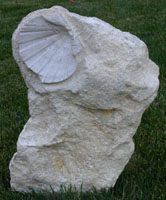Little information is available regarding the geology of the area around Lacoste, France. It has Roman era limestone quarries nearby where the specimen, Plagioctenium (Chlamys) boulogniensis, was obtained. Lacoste, France is best known not for its fossils, but for the Marquis de Sade, its most infamous former resident.
Lacoste is located in Southern France, near the Mediteranean Sea and is slightly above sea level. Based upon its altitude and location, it probably shares a similar geology with the Paris Basin. The Paris Basin is located in the center of the northern half of France (excluding Eastern France, which is more mountainous). The basin is a broad shallow bowl in which successive marine deposits were laid down from the Triassic to Pliocene periods (230-3.7 million years ago). The strata from this area link to those of the English Channel and south-eastern England (the Lyme Regis region, home of Mary Anning). The layers are made up of clays, limestones and chalk. The chalk is made up of a white mud which formed on the sea bottom and was made from the fragments of coccoliths. Coccoliths are the skeletons of tiny algae which floated on the water surface. The white cliffs of the English Channel are made from the shells and the lime from the shells of dead sea creatures which fell to the bottom of the sea. They were then compressed by the ocean and turned to sediment. These sediments were later uplifted or exposed as the seas subsided.
On the English Channel, on the French side, is located the city of Boulogne. Boulogne is located across the Channel from the White Cliffs of Dover. Lyme Regis, England is somewhat more south-easterly. It is likely that this clam was first found and identified in this area since that is what the word boulogniensis means (from Boulogne).
When Latin names are given, the first name describes the plant or animal and is always capitalized. The second name further describes the plant or animal, or is named for the person who found it (by adding an "i" to the end of the last name), or gives the location where it was found or from (by adding the suffix "ensis" to the location). The second name is always lower case.
Plagioctenium (Chlamys) boulogniensis has strong and frequently smooth ribs above with ears of about equal but differing shape below.
This specimen is being offered from a private collection!
Plagioctenium (Chlamys) boulogniensis 
Quantity in Basket: None
Code: FPB-100
Price: $750.00
Shipping Weight: 35.00 pounds
Time: Miocene, approximately 21-12 million years ago.
Location: Lacoste, France.
Dimensions: 17-1/2" x 12" x 5-3/4"